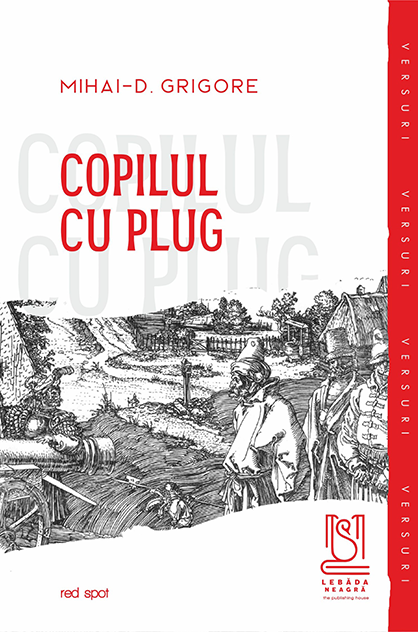- Rating: ★★★☆☆
- Editura: Lebăda Neagră, imprint Red Spot
- Pagini: 126
- Goodreads: Copilul cu plug
- Poate fi cumpărată de aici: https://blackswanpublishing.ro/produse/carti/poezie/copilul-cu-plug/
Volumul de poezii „Copilul cu plug” de Mihai-D. Grigore este o colecție de reflecții poetice pline de imagini bogate și sugestive. Poeziile impresionează prin folosirea metaforelor și a unui limbaj expresiv, explorând teme profunde precum libertatea, lupta interioară, efemeritatea fericirii și relația dintre om și natură. Autorul reușește să creeze un univers poetic plin de simboluri, în care cititorul este invitat să descopere sensuri ascunse.
Una dintre calitățile remarcabile ale poeziilor este forța imagistică. De exemplu, ploaia din poezia „Dincolo de țărm” capătă un rol purificator, transformându-se într-un simbol al renașterii sufletești. Totodată, „Sfârșit de secol” surprinde realitatea socială și umană cu un ton melancolic, dar pătrunzător, subliniind suferința și căutarea unui sens într-o lume adesea nemiloasă.
Totuși, volumul poate părea dificil pentru cititorii care preferă poezii cu un mesaj mai direct. Limbajul dens, încărcat de metafore, poate fi greu de înțeles la prima lectură, iar unele poezii par să repete teme și imagini fără a aduce ceva nou. De asemenea, lipsa unei structuri clare între poezii lasă uneori impresia de fragmentare.
Cu toate acestea, „Copilul cu plug” rămâne o carte interesantă, potrivită celor care iubesc poeziile simbolice și meditative. Este un volum care cere răbdare, dar răsplătește prin frumusețea limbajului și profunzimea ideilor. Oferindu-i 3 stele, putem spune că este o lectură plăcută, dar poate fi o provocare pentru cei mai puțin obișnuiți cu stilul său abstract.



The Child with the Plow – Mihai-D. Grigore
The poetry collection “The Child with the Plow” by Mihai-D. Grigore is a compilation of poetic reflections filled with rich and evocative imagery. The poems impress through their use of metaphors and expressive language, exploring profound themes such as freedom, inner struggle, the transience of happiness, and the relationship between humans and nature. The author succeeds in creating a poetic universe full of symbols, inviting the reader to uncover hidden meanings.
One of the collection’s remarkable qualities is its visual power. For instance, the rain in the poem “Beyond the Shore” takes on a purifying role, transforming into a symbol of spiritual renewal. Similarly, “End of a Century” captures social and human realities with a melancholic yet penetrating tone, emphasizing suffering and the search for meaning in a world often unkind.
However, the volume may feel challenging for readers who prefer poetry with a more direct message. The dense language, laden with metaphors, can be difficult to grasp on the first reading, and some poems seem to repeat themes and imagery without bringing new elements. Additionally, the lack of a clear structure between the poems sometimes gives the impression of fragmentation.
Even so, “The Child with the Plow” remains an intriguing book, suitable for those who enjoy symbolic and meditative poetry. It is a collection that requires patience but rewards readers with the beauty of its language and the depth of its ideas. Giving it 3 stars, one might say it is an enjoyable read, though it could prove challenging for those less accustomed to its abstract style.


Lasă un răspuns